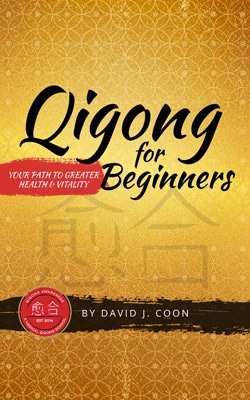Breathing in Qigong consists of channeling Qi and is key to any still or moving practice. It works to restore us to the rhythms of deep, relaxed breathing we once performed naturally as infants. We may not realize it, but most of us have moved away from this type of natural state of breathing throughout our lives, breathing mostly through our mouths and chests. Shallow breathing has become so automatic for us that most of us don’t even think about it. But it can lead to increased stress and anxiety. Qigong breathing is about bringing our awareness back to our breath so we can feel a greater sense of balance and connection to the world.
How is breath connected to Qi?
In scientific terms, our breath is an exchange of oxygen, carbon dioxide, and nitric oxide, which all play a role in the oxygenation of cells the body needs to stay alive and thrive. Qigong takes this science into account while also engaging breath work to harness Qi. If Qi is energy (or universal life force), then the breath can be thought of as spirit. In ancient times, the breath was synonymous with spirit: the first inhale of an infant was thought to be the spirit taking the body into physical life, and the last exhale at death representing the soul departing from the body. When we breathe in fully, we embody the spirit and fill our bodies with Qi. The breath becomes a medium or channel for harnessing Qi—or in Qigong, we say that Qi rides on the breath because Qi enters and exits the body riding on the breath.
Should I breathe out of my nose or mouth in Qigong?
Like many subjects within Qigong, there are different opinions on whether it is best to exhale through your nose or mouth. Some say breathing in and out through the nose offers the greatest relaxation, unless you have nasal issues or are physically unable to do so. Others say that breathing in through the nose and out through the mouth rids the body of unwanted toxins and allows for greater oxygen intake. Both serve different purposes, and can even go with different kinds of Qigong practice.
One benefit of breathing in and out through the nose is that it is effective at calming the nervous system. It immediately lowers blood pressure and reduces stress levels. Because of this, it is great for helping clear your mind and for quiet meditation.
Separately, breathing in through the nose and out through the mouth can be an extremely powerful form of release. Many Martial Arts, for example, emphasize this breathing method while also incorporating sounds upon exhalation. These sounds can be loud, like the hisses of a cat; other times, they are guttural or high-pitched. While Martial Arts is not the same as Qigong, we can think of it like a cousin: they share overlapping philosophies and practices, including the cultivation of Qi. Some Qigong teachers and masters even have a Martial Arts background and bring these methods into their teachings. The tremendous force generated by breathing in through the nose and out through the mouth can be a powerful release of tension in Martial Arts, and the same is true for Qigong. The cathartic effects of this breathing method help chase off fear and promotes a greater sense of being grounded.
How to Practice Qigong Breathing
Just like there are many different styles of Qigong meditation and exercise, there are many different methods of breathing.
Exercise 1: Basic Breathing Method
The most basic breathing method in Qigong—also practiced in yoga and other forms of meditation—is sometimes called circular breathing, infant breathing, or pranayama breathing. Aiming to restore the deep breathing patterns of our infancy, it focuses on breathing into the lower belly, also known as the lower Dan Tian in Traditional Chinese Medicine.
Start by breathing in slowly through the nose, allowing your breath to fill the lower abdomen first. Then, let it fill your upper abdomen, followed by the lungs. Exhale in reverse: release air slowly through the nose, allowing your breath to exit the lungs first, followed by the upper abdomen, then the lower abdomen. Repeat this pattern for a length of time.
Qigong breathing should be done gently, with little effort. It can be done while seated or standing or it can be incorporated into a physical moving practice. It can sometimes be beneficial to practice while still so that you are not thinking about too many things, which can happen when practicing a moving Qigong exercise. This breathing method is sometimes practiced with the tip of the tongue pressed to the roof of the mouth, just behind the two front teeth, though this is more common in still practices rather than in moving practices. The tongue is said to connect with the ren and du acupuncture channels, also known as the “conception vessel” and the “governing vessel,” creating a circuitry of energy that we call the Microcosmic Orbit.
Exercise 2: Microcosmic Orbit Breathing
Microcosmic Orbit Breathing has the same breathing pattern as basic breathing but incorporates more meditation and creative visualization techniques. It not only focuses our breath into the lower Dan Tian but aims to cultivate Jing. Jing, meaning “essence,” is one of the three main energy centers in our bodies: located near the lower abdomen, it is associated with sexuality and physicality. In this exercise, we circulate Jing, bringing it into our bodies for equilibrium (ejaculation or menstruation are thought to be a depletion of this energy). It is often said that harnessing Jing is necessary before Qi can be developed.
Begin with your basic breathing practice. As you breathe in through the nose, imagine drawing energy, in the raw form of Jing, up your back and all the way to the top of your head. Upon exhaling, release your breath and allow the energy to travel from your head through your tongue and down the ren channel—the meridian that connects your lips to the lowest point of the trunk of your body. Allow the energy to make its way back to the lower Dan Tian, resting between the genitals and the anus (called the perineum). Repeat this breathing method for a length of time, focusing on the circulation of Qi. There is no exact number of times you should repeat this exercise, but if you’re not sure, we suggest trying 33 times. 33 is a sacred number, and it will allow you to get a feel for the breathing exercise. Once you finish, bring your attention back to the lower Dan Tian and lower belly, just below the navel center (you may want to place both hands there during and/or after the practice is complete). Finish by taking a few breaths, letting go of the Microcosmic Orbit Circulation and bringing your attention back to lower belly breathing for at least several rounds to ground yourself and your energy.
David’s Video: “Are there different types of Qigong Breathing?”
See our YouTube channel for more video content.







